bulletin | feature story
Fox Thorpe

Chair’s update on PCSA activities and welcome to the student ACerS Bulletin issue
By Fox Thorpe, PCSA chair
The impermanent nature of life as a student imparts the necessity of an effective community.
From collaborative research and peer review to mentorship and camaraderie, community is central to our career and personal experiences. While we all strive to learn continuously, no one remains a student forever, and while our studies are our own, no one is a student alone. The ensemble of our mentors, colleagues, collaborators, and friends provides a network that enriches our personal growth and professional development.
READ MORE

2022–2023 PCSA delegates at the PCSA annual meeting in October 2022. PCSA chair Fox Thorpe (center with blue jacket) stands with then-ACerS president Beth Dickey (right of Thorpe).
Credit: ACerS
When beginning their studies, students often find themselves in a new place, learning new things, surrounded by new people, and looking for a new home. Within ceramics, many students find their new home within ACerS. This year’s issue of the Bulletin will feature student perspectives on the impact of the ceramics community.
The ACerS President’s Council of Student Advisors (PCSA) began its year with a self evaluation and restructuring to better serve the ACerS community and represent students. In October 2022, the PCSA and its 46 student representatives, from 28 universities and eight countries, created its vision for the year.
- The Conference Programming Committee is organizing conference activities focused on engaging students and enriching the conference experience. They recently organized and hosted career panels at EMA and ICACC and the shot glass drop competition at ICACC.
- The Professional Development Committee is a new committee focused on helping students grow their professional network and navigate the professional landscape. This committee is currently organizing webinars and a professional development event at ACerS Annual Meeting at MS&T 2023.
- The Education Committee is creating lesson plans and online tools, which complement the Materials Science Classroom Kits, to enable and empower anyone to perform K–12 outreach activities for ceramics and glass science. They are also working to establish local programs with robust and sustained outreach collaborations.
- The Communications Committee is generating engaging content to educate others about ceramics and ACerS events.
- The Recruitment and Retention Committee is looking for the next group of motivated and committed PCSA delegates. They are also focusing on helping and encouraging students to remain within ACerS after they graduate.
Additionally, the PCSA has instituted a diversity, equity, and inclusion taskforce to ensure its practices and activities are best suited for any students who wish to participate.
I am personally grateful to the ACerS community, where I have grown my professional network, learned invaluable lessons, and made lifelong friends. It is my hope that you enjoy this year’s student issue of the ACerS Bulletin.
About the author:
Fox Thorpe is a Ph.D. candidate at the University of California, Davis, studying in the McCormack Lab. As the 2022–2023 PCSA chair, he seeks to make the PCSA a more efficient and effective organization to better realize its goals in serving and representing the student community.
COLLAPSE ARTICLE ABOVE
Congressional Visits Day 2023 recap
By Yolanda Natividad, ACerS liaison to the Material Advantage Student Program
The Material Advantage Student Program’s Congressional Visits Day 2023 (CVD) was back to in person for the first time since 2019. This year’s event took place on April 18–19, 2023.
The annual Material Advantage CVD event gives students an opportunity to visit Washington, D.C. to educate congressional decision makers about the importance of funding for basic science, engineering, and technology.
READ MORE
Students and faculty from the following universities participated in this year’s event. Some university teams managed to schedule eight different appointments with their various members of Congress!
- Alfred University
- Case Western Reserve University
- Colorado School of Mines
- Iowa State University
- Northwestern University
- The Pennsylvania State University
- The University of Alabama
- University of Connecticut
- University of Florida
- University of North Texas
- University of Tennessee Knoxville
- University of Utah
- University of Virginia
- Washington State University
Each year, the CVD experience begins with an opening reception. The 2023 reception on April 18 featured talks by Alessandra Zimmermann, writer and analyst for the R&D Budget and Policy Program at the American Association for the Advancement of Science, and Jakob Lindaas, legislative assistant in the office of U.S. Sen. Martin Heinrich.
After talks concluded, students were shown the dos and don’ts of a congressional visit, in addition to a chance to do some role-play interactions in advance of their appointments on the following day.
Thank you to David Bahr, head and professor of materials engineering at Purdue University; Iver Anderson, senior metallurgist at Ames Laboratory and adjunct professor in the materials science and engineering department at Iowa State University; and Megan Malara, director of medical modeling, materials, and manufacturing at the Center for Design and Manufacturing Excellence at The Ohio State University, for conducting training and for their assistance in helping to coordinate the CVD event.
We look forward to being back in D.C. again next year. If you are a student and did not get a chance to participate this year, make sure that you register EARLY for the 2024 CVD event. Or if you are a professor/faculty advisor, make sure to plan on gathering a group together from your university.
Visit the Material Advantage website for future updates. It is an opportunity that you will not want to miss!

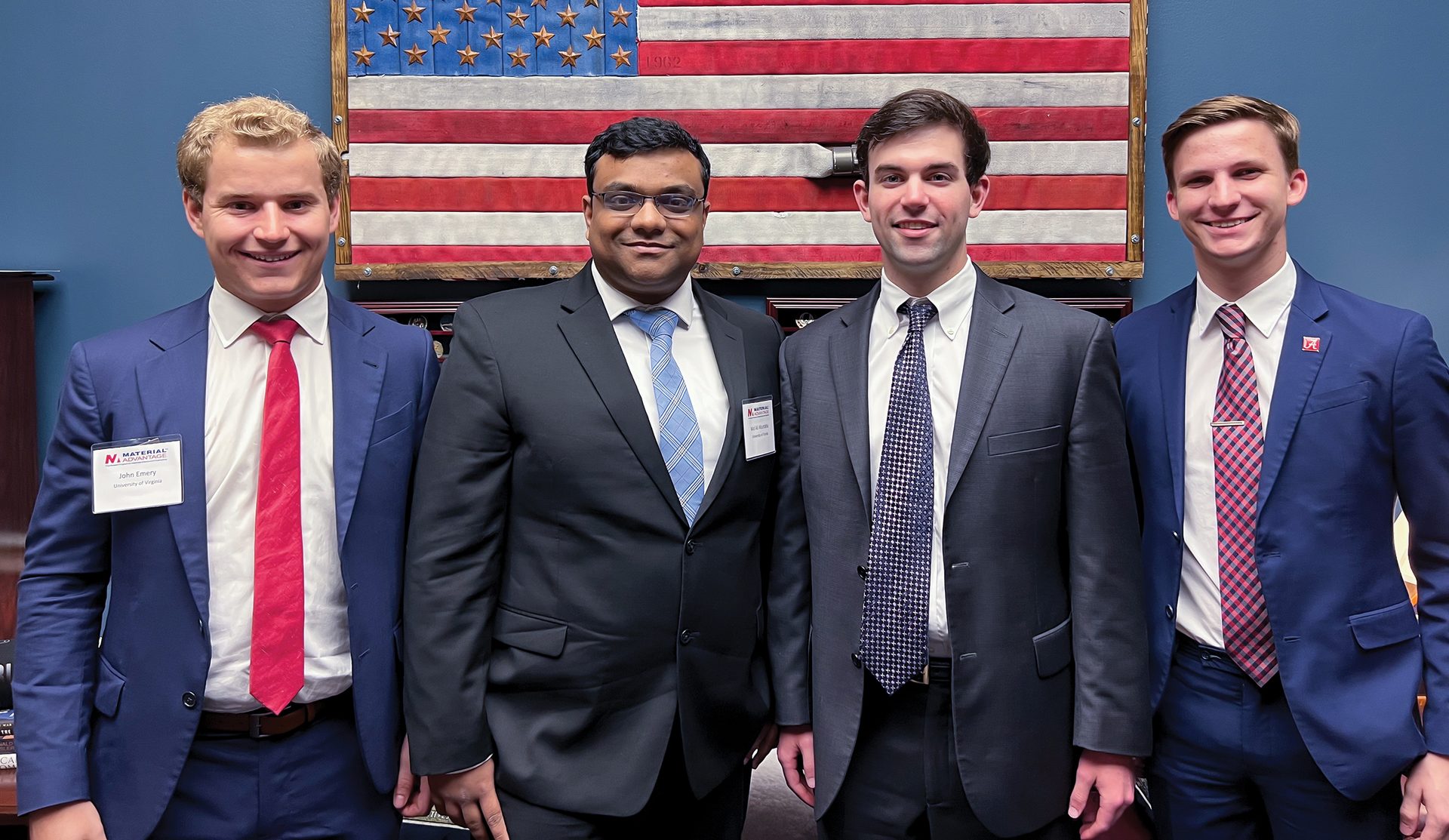


COLLAPSE ARTICLE ABOVE
Benazir Fazlioglu-Yalcin
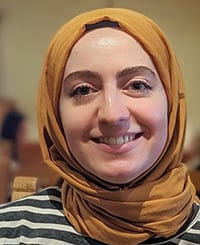
Appreciating the breadth and depth of the materials science community
By Benazir Fazlioglu-Yalcin
As a student who was always enthusiastic about studying and controlling change in life, I decided to pick a major where I could touch, smell, and see change. Unsurprisingly, chemistry soon became the top runner of my choices.
I loved the way teaching was done in the chemistry department at my undergrad university, Boğaziçi University in Turkey. The curriculum consisted of theory classes followed by student labs, which gave us the opportunity to apply what we learned in classes. I still get excited remembering the first time I saw an iodine solution changing its color from deep purple to a completely transparent solution during a redox reaction—and it was happening in my test tube!
READ MORE
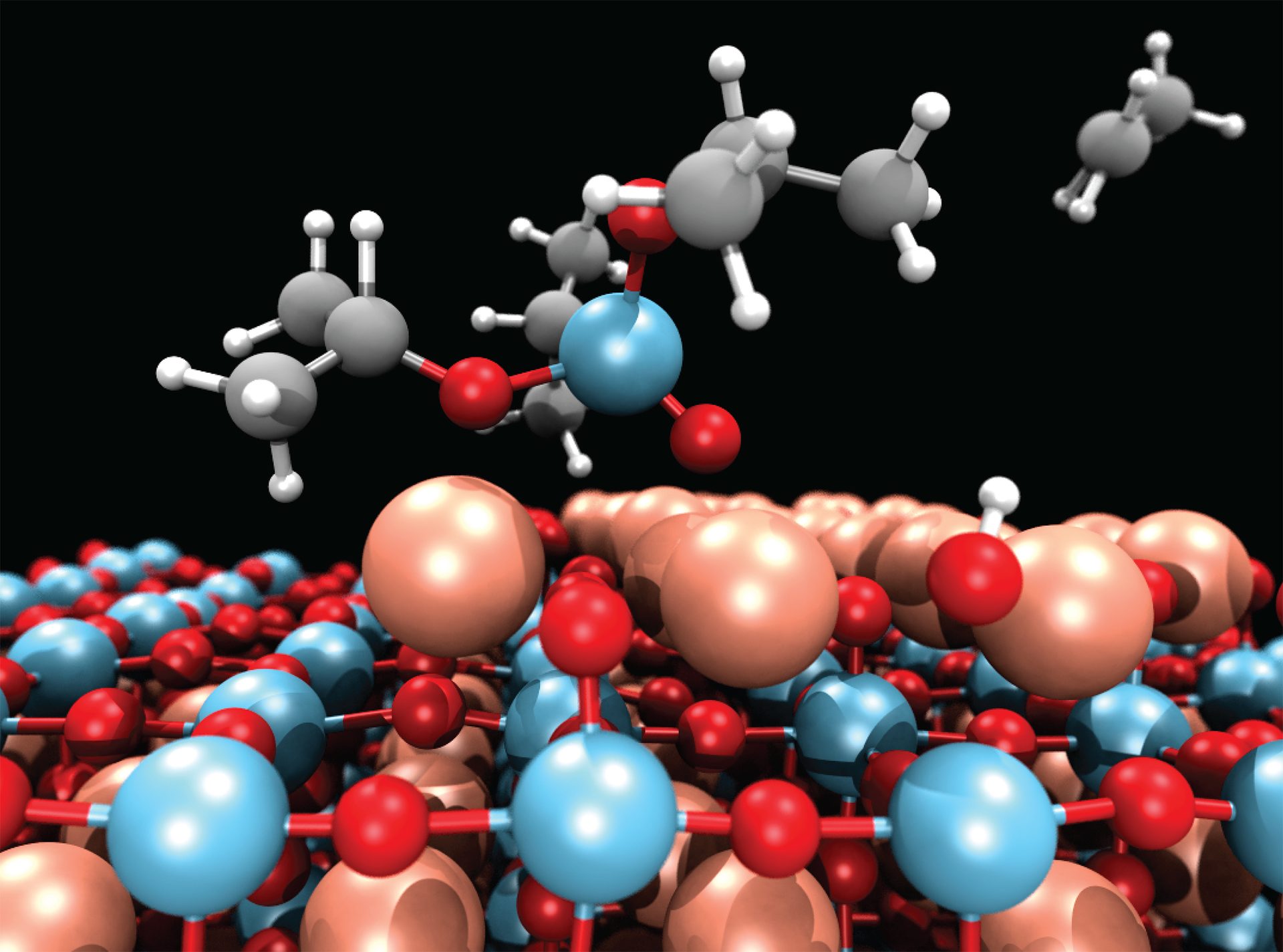
Snapshot from a ReaxFF molecular dynamics simulation showing the decomposition of a titanium-based metal-organic compound on a SrO-terminated SrTiO3 thin film.
Credit: Benazir Fazlioglu-Yalcin
As I progressed through my undergraduate degree, I started moving toward the materials science side of things as I became aware of the importance of studying and controlling change on a bigger scale. This realization led me to pursue my Ph.D. journey in the Department of Materials Science and Engineering at The Pennsylvania State University, with a focus on experiment rather than theory.
The Penn State materials science and engineering department is diverse with people coming from numerous different disciplinary backgrounds, including physics, chemistry, and various engineering fields. Despite these differences, students in the department share a love of materials. This love is what bonds the greater materials science community, regardless of whether you specialize in polymers, metals, or ceramics.
Because of this diverse pipeline of students entering materials science, the community benefits from a wide array of skills that can lead to immediate and fruitful collaborations on both small and large scales.
For example, the first time I truly appreciated this meshing of disciplines was during a study group session where my friends and I were struggling with a homework question. The question was somewhat related to chemistry, and my friends asked me to go to the whiteboard and explain that specific concept to them. That moment really made me feel like a part of the community.
Later on in my Ph.D. journey, I was the one benefitting from the materials science community’s vast knowledge base. One of my advisors suggested that I learn how to use computational tools and simulations to back up my experiments. As someone who prefers to physically interact with change, simulations did not appeal to me. However, during the COVID-19 pandemic, we were not allowed to go to our labs. So, learning how to integrate computational tools into my research was the only thing I could do.
With guidance from my advisors and others in my two research groups, I learned how to use various computational tools and gained an appreciation for such research. Now, I see myself as a half-experimental, half-computational materials scientist.
My current research involves growing thin films of ceramic oxides using an advanced technique called molecular beam epitaxy. I also run ReaxFF molecular dynamics simulations, which allow me to “observe and control” change that we cannot see with our bare eyes. The combination of these two approaches constitutes a powerful tool for the questions we have as scientists.
New research ideas come to my mind every day, and these ideas excite me despite knowing that, to realize them, I must come out of my comfort zone even more than I already have. At this point, though, I am confident there will always be someone with the expertise and willingness to help me, thanks to the breadth and depth of the materials science community.
About the author:
Benazir Fazlioglu-Yalcin is a fourth-year Ph.D. candidate in materials science and engineering at The Pennsylvania State University. Her research focuses on BaTiO3 thin films and atomic-scale ReaxFF simulations of them. She enjoys reading and listening to novels, woodburning, pencil drawing, hiking, and spending time with her cat, Siva.
COLLAPSE ARTICLE ABOVE
Luz Gomez
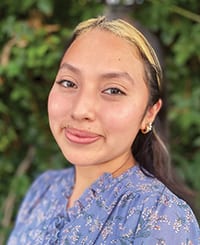
Using materials science to benefit marginalized communities
By Luz Gomez
Throughout my undergraduate education, I struggled to feel a sense of belonging. As a first-generation Latina student from a low-income community in Los Angeles, Calif., my first few years in university were challenging to navigate.
I started my educational journey at the University of California, Irvine, as a political science major. The desire to benefit marginalized communities, such as my own, influenced my decision to join a program that helped me better understand the systems of government. During my first year, however, my interest in engineering grew because of enjoyable chemistry and physics classes. By the end of my first year, I changed my major to materials science and engineering.
READ MORE
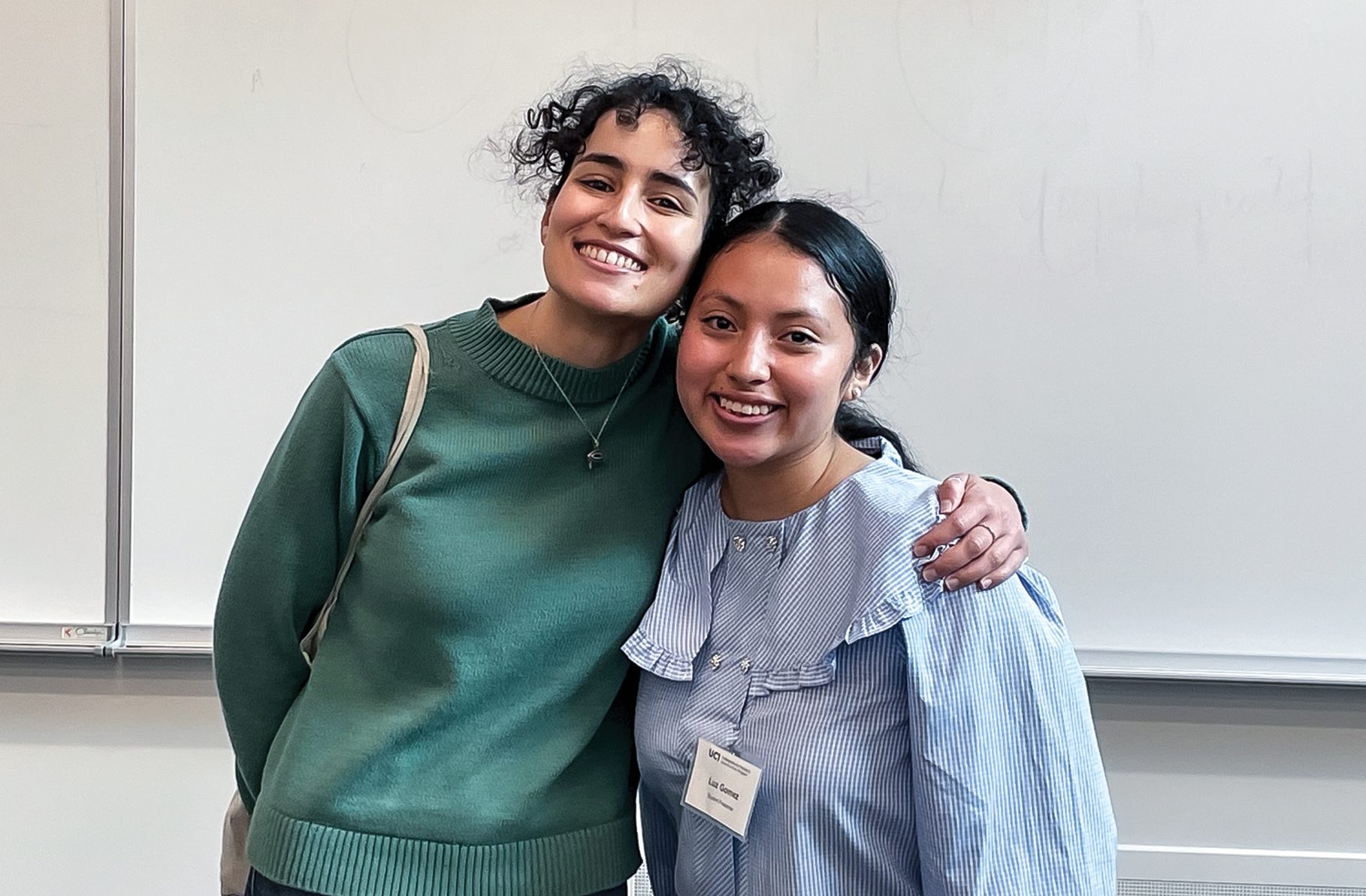
Luz Gomez, right, and graduate student mentor Salma El-Azab at the University of California, Irvine’s Undergraduate Research Symposium.
Credit: Luz Gomez
Unfortunately, as I transitioned into my new program, the COVID-19 pandemic started. The mandatory transition to online for all social and academic activities hindered my ability to connect with my materials science peers.
Fortunately, through luck and personal effort, I began making inroads into the materials science community. I was delighted to discover that my initial desire to benefit marginalized communities could still be achieved through the materials sciences, as demonstrated in the examples below.
Inspiring the next generation through Girls in STEM
In the summer of 2020, I stumbled upon a club at UCI called Girls in STEM.1 Girls in STEM aims to promote science, technology, engineering, and mathematics to high school girls in disadvantaged communities and provide resources that would make the transition to higher education easier.
I joined Girls in STEM, and through this club I mentored a handful of girls in high school, plus facilitated workshops on different engineering disciplines and my own experiences in the field.
Helping disadvantaged communities through green engineering
In my fourth year at UCI, school proceeded back to in person. I decided to take advantage of this last year and reached out to professors for hands-on research experience.
I was intrigued by materials science professor Julie Schoenung’s research on sustainability and green engineering. Low-income communities of color, such as my own, face greater risks from environmental hazards because they are more likely to live near sources of industrial pollution, such as oil drilling and refineries.2 Working toward green technology and clean energy would benefit these communities the most. So, I joined Schoenung’s research group as an undergraduate research assistant in winter quarter 2022.
I worked independently alongside a graduate student to investigate the mechanical properties of high-entropy oxides, a novel ceramic material with potential applications in energy storage, lithium-ion batteries, and catalysts.3 In the laboratory, I fabricated samples, investigated their mechanical properties through hardness testing, helped build equipment, and observed several advanced synthesis and characterization methods.
In addition to gaining valuable technical skills, these experiences were the first time I had worked with people who, like me, wanted to use materials science to benefit society. Such interactions gave me more confidence in myself and my skills, and talking with graduate students opened my eyes to graduate school as a way to achieve my goal of helping others.
Pursuing diversity and inclusion through engineering education
My decision for what to pursue in graduate school was influenced by a class in fall 2021 that I took with assistant professor of teaching Natascha Buswell. She mentioned her background in engineering education during the class, and I reached out to her over the summer to learn more about the discipline and her research. In fall 2022, I joined Buswell’s research group, where I learned about diverse engineering education research methodologies and ongoing developments in inclusion and diversity in engineering education.
Through my work with Buswell, I learned that this field would support my goal to establish a sense of belonging for marginalized groups and create an educational environment in which they can thrive. I decided to pursue graduate studies in engineering education, and I will begin my studies at The Ohio State University in fall 2023.
References
2 “Environmental Justice | Communities for a Better Environment.”
3 M. Fu, X. Ma, K. Zhao, X. Li, and D. Su., “High-entropy materials for energy-related applications,” iScience 2021, 24(3):102177.
About the author:
Luz Gomez recently graduated with a B.S. in materials science and engineering from the University of California, Irvine. Her research focused on mechanical properties of high-entropy ceramic oxides. In fall 2023, she will begin her graduate studies at The Ohio State University in engineering education. She is passionate about her community and spends her free time volunteering in organizations promoting diversity in engineering.
COLLAPSE ARTICLE ABOVE
Randi Swanson
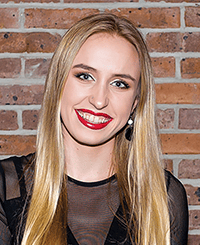
‘Life’ experience, ‘liberty’ to experiment, and the ‘pursuit’ of science
By Randi Swanson
New experiences are often intimidating, but as my advisor likes to tell me, “It’s good to be nervous; that means you care.” While I was not necessarily intimidated to spend an entire summer alone in Dayton, Ohio, at the Air Force Research Laboratory (AFRL), I was definitely apprehensive in the sense that I did not know what to expect.
READ MORE

Randi Swanson, far right, takes a selfie with AFRL research materials engineer Katie Detwiler and materials research intern Tyriek Craigs during a monthly Wingman event, in this case canoeing. Each research team at AFRL sponsors Wingman events to provide team-building opportunities for group members.
Credit: Randi Swanson
I had already moved across the country once for graduate school at the University of California, Davis, so I was not a stranger to readjusting and making friends in a new environment. As anyone who has relocated for the short or long term knows, the difficulty of adapting can be significantly alleviated by the people surrounding you. At UC Davis, I was surrounded by like-minded students my age who were going through the same journey as myself. However, at AFRL, this would not be the case.
The opportunity to spend a summer at AFRL came about because, at UC Davis, I am graciously being funded by the United States Air Force. My research focuses on characterizing the microstructure of ultrahigh-temperature ceramics (UHTCs) using 3D characterization techniques to track flaws throughout processing. The choice of processing parameters affects the “critical flaw size” distribution in the microstructure; however, the specifics of this relationship are difficult to model and thus must be characterized in further detail. This research requires access to experimental techniques that are not widely available, such as X-ray micro-computed tomography (X-µCT). I do not have access to this technique at UC Davis, but I do have access to it at AFRL.
We all have preconceived notions about new experiences based on our previous experiences. I would be lying if I said I did not expect the environment at the AFRL to be a bit intense—militaristic, if you will. However, my preconceived notions could not have been farther from the truth.
While there was of course the expectation to perform to the best of your ability, as in any job, I was happily surprised by the welcoming, diverse, and supportive colleagues that I had the honor of working with all summer. The scientists who work at AFRL, from new hires to project managers, treated me with the upmost respect, which made me feel confident in my research and presentation experiences.
The pleasant atmosphere was not the only aspect of the AFRL that made the overall experience experimentally fruitful. As previously mentioned, my research requires access to instruments that are not ubiquitous, such as X-µCT. The X-µCT laboratory at AFRL allowed me to gather significant amounts of data on UHTC microstructure characterization, and these scans account for most of my Ph.D. research data thus far.
The X-µCT laboratory manager, Thao Gibson, not only helped with data acquisition, but she also took the time to discuss the particularities of computed tomography to ensure I had a firm understanding. This anecdote is just one example of the benevolent nature of the laboratory personnel that has no doubt aids in AFRL’s scientific success.
The culture at AFRL is a great example of how a positive environment generates more collaboration and scientific breakthroughs. With a budget of more than $2 billion, AFRL is constantly developing science and technology through in-house and contractual programs.1 The success of AFRL is not just due to the brilliant scientists that are employed there, but also to the environment of respect and curiosity that is culminated every day.
References
1 “Air Force Research Laboratory (AFRL) Wright-Patterson Air Force Base (WPAFB) OH FACTSHEET.” Accessed 22 March 2023.
About the author:
Randi Swanson is a second-year Ph.D. student in chemical engineering at the University of California, Davis, studying microstructure evolution of ultrahigh-temperature ceramics for aerospace applications. In her free time, she enjoys playing the piano and laughing with friends.
COLLAPSE ARTICLE ABOVE
Cassondra Brayfield

Toward a green community: Tuning electrochemical parameters to improve morphology of Sb2Se3 solar absorber layers
By Cassondra Brayfield
Due to fossil fuel use in the hundred years between 1900 and 2000, the amount of CO2 rose by 132.5 parts per million per volume (ppmv), which corresponds to 2.51 W/m2 of radiative force on the environment.1,2 This rise in greenhouse gas emissions has led to noticeable changes in sea level and global temperature.3
READ MORE
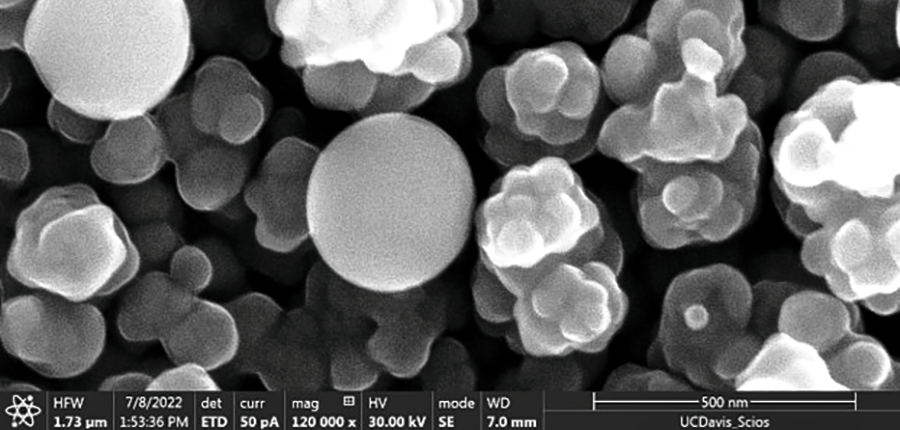
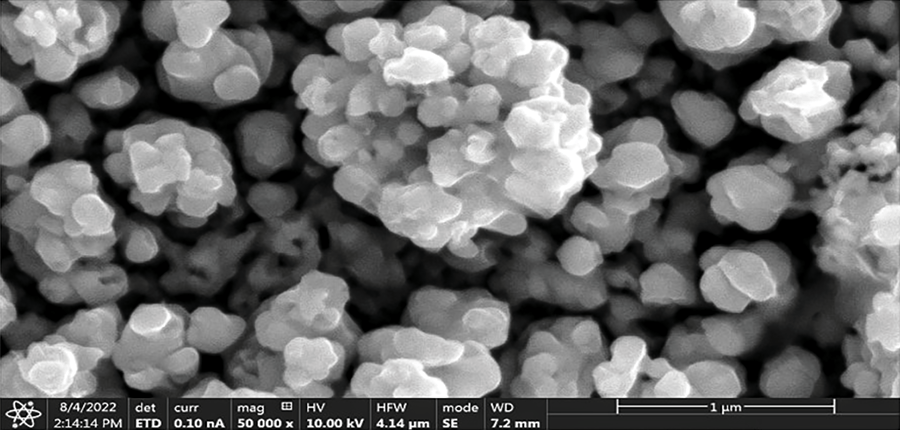
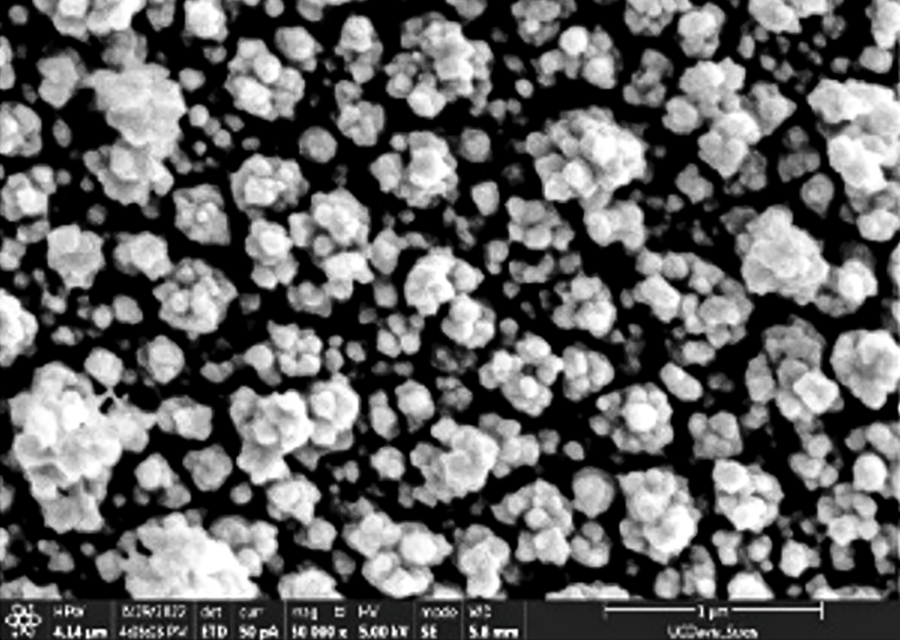
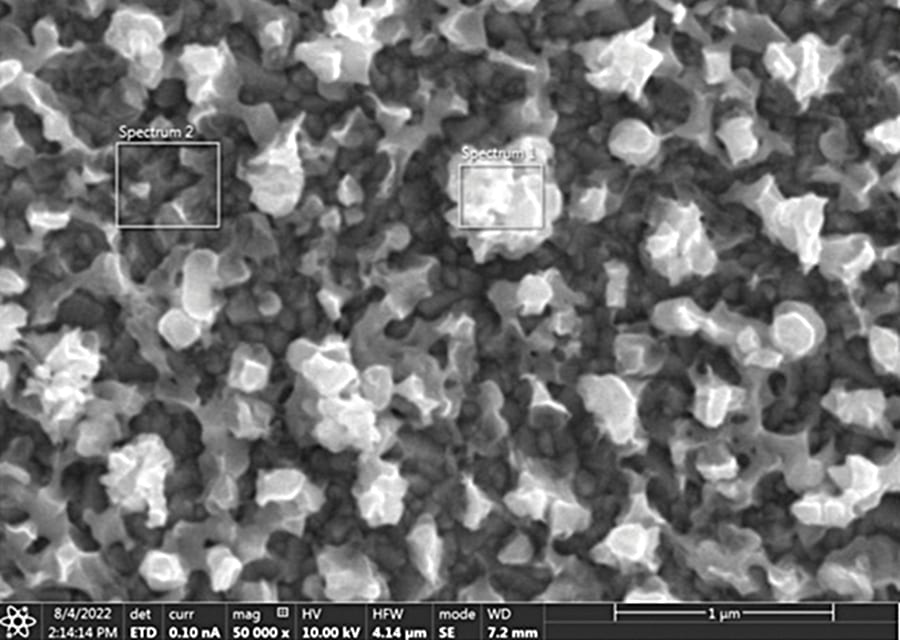
Figure 1. The left sample (a) did not receive KMnO4 treatment, while the right sample (b) did receive treatment, resulting in a homogeneous field of separate globular nanoparticles.
Credit: Cassondra Brayfield
Figure 2. The left image (a) is the original deposited film, while the right image (b) shows the same film after annealing, leading to a merging of the globular nanoparticles.
Credit: Cassondra Brayfield
To have any chance of slowing or reversing this process, academic, industrial, and government communities must work together to make the switch to renewable, carbon-neutral energy sources.
Solar is one green energy sector that has witnessed much cross-community collaboration, particularly in the design of photovoltaic panels. Photovoltaic panels are multilayered modules that convert solar energy into electricity. Researchers in academia, industry, and government have explored many different compositions for these layers in pursuit of an earth-abundant, nontoxic, and efficient design.
The absorber layer has the greatest potential for improvement. It is the layer that functionally absorbs the sunlight and, via an n-type or p-type region, converts the sun’s energy into usable, storable energy.
Some materials studied for the absorber layer include CdTe, Cu(In,Ga)Se2, Cu2(Zn,Sn)S4, and recently Sb2Se3.
The downside to the former three options is that indium and tellurium are scarce, and cadmium is toxic to humans.4 In contrast, antimony and selenium are relatively plentiful and nontoxic.
Thin films of Sb2Se3 have been produced through various methods, including reactive pulse laser deposition, spin-coating, spray pyrolysis, thermal evaporation, and physical and chemical vapor deposition. But many of these methods are considered nonuniform and/or expensive.
Electrochemical deposition is an alternative thin film manufacturing technique that has minimal waste, easy setup, and low cost. Plus, because one chemical bath can be used repeatedly, it has large potential for industrial scalability.5
Many parameters of the electrochemical deposition process are tunable, providing great control over the final thin film’s properties. In the Osterloh research group at the University of California, Davis, we are exploring these parameters to achieve ideal Sb2Se3 film deposition.
For example, we discovered that an increase in the deposition temperature allows for more nucleation sites to deposit at the start of the process. These close-knit sites lead to denser particle growth, which results in more conformal films. (Increasing the temperature any higher than 70°C, however, will cause the solution to boil, leading to holes in the film.)
We also found that adding KMnO4 to the chemical treatment the film undergoes before deposition leads to a film with stronger atomic bonding. Plus, compared to untreated films, the uniformity and conformity of particles in the KMnO4-treated films are much greater (Figure 1).
Finally, we showed that annealing the film after deposition in an argon atmosphere infused with additional selenium powder improved the film’s density, coverage, and homogeneity, as well as its selenium content (Figure 2).
Future work must be done to observe how these Sb2Se3 absorber layers perform when integrated with a full device. It would also be interesting to perform the annealing treatment prior to the electrochemical deposition to determine if it leads to even better nucleation due to a possible seed coating.
References
1 M. Lockwood, “Solar change and climate: an update in the light of the current exceptional solar minimum,” Proceedings of the Royal Society A 2010, 466(2114).
2 R. Lindsey, “Climate change: Atmospheric carbon dioxide.” Climate.gov, 23 June 2022.
3 “Climate change 2022: Impacts, adaptation, and vulnerability.” Intergovernmental Panel on Climate Change Sixth Assessment Report.
4 M. Kumar et al., “Strategic review of secondary phases, defects, and defect-complexes in kesterite CZTS-Se solar cells,” Energy Environ. Sci. 2015, 8:3134–3159.
5 Y. H. Kwon et al., “Crystal growth direction-controlled antimony selenide thin film absorbers produced using an electrochemical approach and intermediate thermal treatment,” Solar Energy Materials and Solar Cells 2017, 172:11–17.
About the author:
Cassondra Brayfield is a Ph.D. candidate in materials science and engineering at the University of California, Davis. She is currently working on a variety of energy science projects, including synthesizing catalysts to produce alternative fuels and deposition of the absorber layer for photovoltaic cells. When not researching or teaching, she is also interested in ballet, wine, swimming, reading, throwing parties, and all things outdoors.
COLLAPSE ARTICLE ABOVE
Arturo Meza
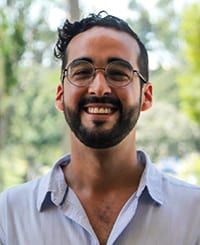
Graduate Interconnect program: Guiding a successful transition for incoming international students to graduate student life
By Arturo Meza
The pursuit of an academic degree can take you to many places around the world. The United States, however, is a common landing place for students.
According to the Open Doors 2022 Report on International Education Exchange,1 as of the 2021/22 academic year, there are 948,519 international students in the U.S. Though these students come from many different cultural backgrounds, they do share one thing in common: a home far away from their university.
READ MORE

Group photo of the 2022/23 Graduate Interconnect program peer mentors.
Credit: Graduate Interconnect program
While transitioning to a different culture may be easy for some, it is challenging for many others. To help with this transition, the University of California, Irvine (UCI) developed a peer mentor program that provides a supportive community for international students in their new home away from home.
The Graduate Interconnect program (GIC) is run by the division of graduate education at UCI.2 The division extensively trains domestic and international graduate students who wish to play the role of mentors within the program. These peer mentors then conduct outreach with international students, even before the incoming students arrive on campus.
GIC peer mentors guide incoming international students on what to expect upon arriving in their new community. They provide information on where to buy essential items, such as furniture and groceries, and even offer advice on how to make new friends. GIC peer mentors also provide international students with details about the variety of campus resources available to them, including how and when to access them.
Most fun of all are the social events put on through the GIC program to help incoming international students engage with their new community, make friends, and share experiences that ultimately help them build a network. For example, the GIC fall quarter mixer is a social event where all the mentees gather on campus—either the UCI graduate housing community or a designated campus venue—with food and beverages provided by the GIC program.
Throughout my time at UCI, I was very lucky to be part of the GIC program as a mentee and as a mentor. I came to UCI from my hometown of Hermosillo, Mexico, where I also got a B.S. and M.S. in materials science and engineering. When I started graduate school, my peer mentor came from the same department and coincidentally was a member of the research group that I later joined. This arrangement helped me engage socially and professionally in my department and community.
The GIC program also informed me of other campus resources, such the UCI Fresh Hub that provides basic needs for UCI students. Plus, relevant information included in the Graduate Interconnect blog written by current graduate students helped me manage my time and focus on my studies and research.3
The impact the GIC program had on me when I arrived at UCI motivated me to serve as peer mentor in my later years, as I was eager to transfer my experiences to incoming international students and help them become a part of the community as effectively as I did.
References
1 “Open Doors 2022 Report on International Educational Exchange,” IIE Open Doors.
2 Graduate Interconnect Program - UCI Graduate Division.
About the author:
Arturo Meza is a fifth-year Ph.D. student at the University of California, Irvine, in the materials science and engineering department. He studies the electrical behavior of novel ceramic materials for industry applications. Outside of research, he enjoys camping in nature, stargazing, and is passionate about astrophotography.
COLLAPSE ARTICLE ABOVE
Salma El-Azab
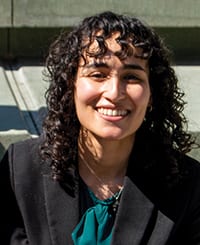
Navigating a Ph.D. with the help of our Graduate Student Association
By Salma El-Azab
When I moved across the country to begin graduate school in the fall of 2019, I was bright-eyed, hopeful, but nervous about what to expect. Would I be able to balance my coursework with graduate research? Would I even like the research topic once I became more deeply involved with the field?
During my first semester at the University of California, Irvine, everything went smoothly, which assured me that I had made the perfect choice. I did well in my courses, got the lay of the lab, and made amazing new friends in my department.
READ MORE
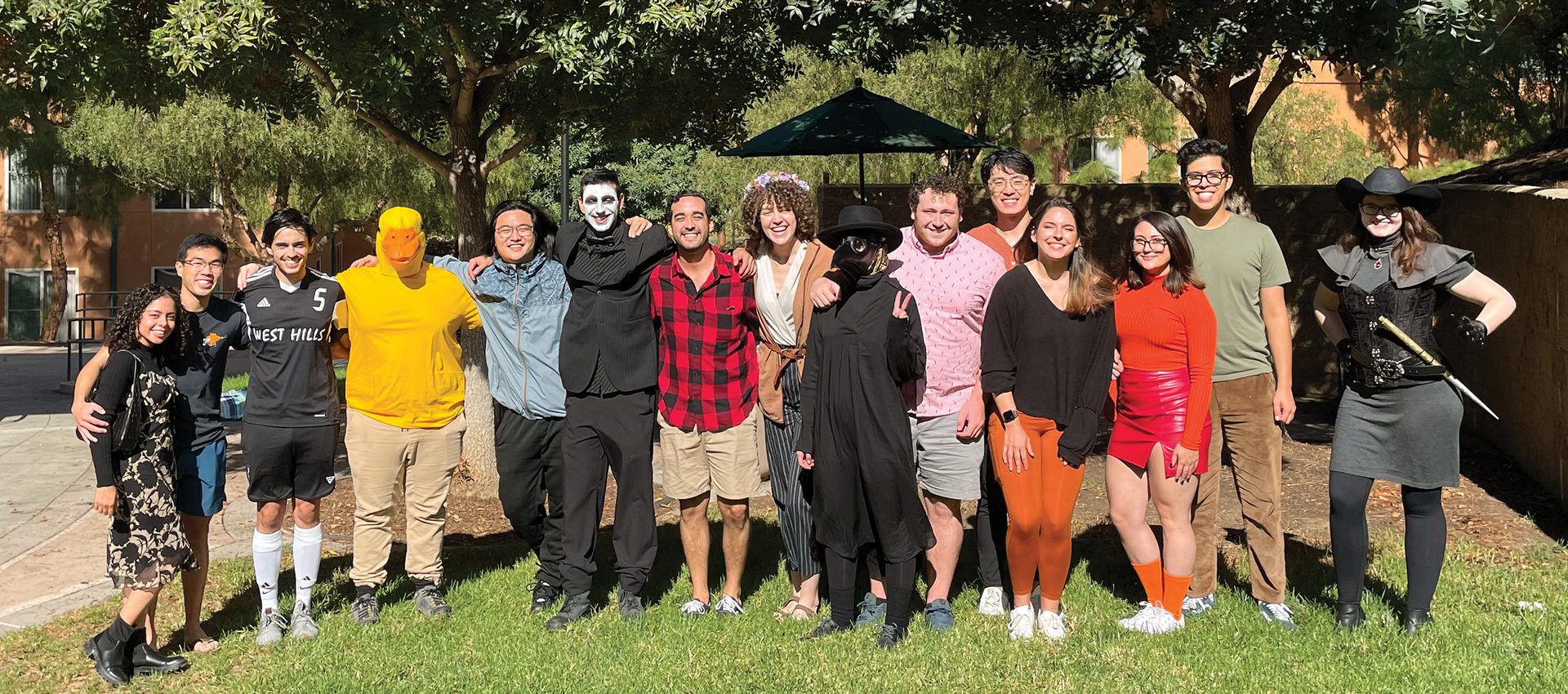
UCI materials science and engineering Graduate Student Association Halloween party, October 2021.
Credit: Salma El-Azab
I also got involved in my department’s graduate student association (GSA) during my first term of graduate school. GSAs provide a central base for graduate students to socialize, participate in outreach, and seek out professional development opportunities. But the importance of GSAs in building a strong student community was thrown into sharp relief in March 2020.
In mid-March of 2020, I volunteered with GSA to help put on our department’s annual recruitment event for prospective graduate students. By the next week, though, the whole world was under lockdown due to the COVID-19 pandemic.
It would be more than half a year before I returned to the lab. But I was still able to maintain some semblance of normalcy in other aspects of my graduate school life through GSA. For example, GSA successfully engaged students through virtual mixers and research-based contests, plus organized virtual outreach events for children in the local school district.
By the time I began my second year of graduate school, I successfully ran to be vice president of GSA. I wanted to help my peers and incoming students maintain a sense of community that had been tarnished by the onset of the pandemic.
To do so, I helped coordinate more virtual events, such as the ones mentioned above. Most notably, in spring 2021, we ran an entirely virtual recruitment event that provided prospective students with robust resources to get a good perspective on our program and our campus. This included videos that we recorded, edited, and narrated about our shared research facilities, housing options, and things to do in Southern California.
I was elected president of GSA by the start of my third year. At this point, things had transitioned back to being in-person, which presented a challenge for GSA. How would we engage graduate students who were burnt out on online functions, plus an additional two cohorts who had no exposure to what our department was like before the pandemic?
To address this challenge, we would need to successfully engage students both socially and professionally. While social engagement was easy enough—we had plenty of experience planning mixer events—the professional engagement required a bit more effort.
Since the pandemic, students missed out on a lot of professional development opportunities, such as conferences, internships, and networking. As GSA president, I spearheaded several professional development opportunities. For example, we brought in guest speakers from different career paths to show students what they could do with a degree in materials engineering. A patent lawyer, a policymaker, and an entrepreneur are just a few of the people who came to network with students and answer their questions.
I also started back up the tradition of connecting undergraduate students to graduate students through mixers. Such mixers provide undergraduate students a way to learn about graduate school and laboratory research from those with first-hand and immediate knowledge on the topic. I met undergraduate Luz Gomez through a GSA-sponsored connection mixer, and working with her has been an excellent opportunity for me to bolster my mentorship skills as well as learn about project management and technical communication.
The world may have changed in ways we could have never anticipated, but at least for graduate students in the materials science and engineering department at UCI, things have only gotten better. GSA provided a community through which to restore the strong sense of camaraderie that blurred during the pandemic. Leading this work gave me the confidence and sense of belonging that I needed to push my own research forward.
About the author:
Salma El-Azab is a fourth-year Ph.D. candidate in the Department of Materials Science and Engineering at the University of California, Irvine. She is a member of professor Julie Schoenung’s group, where she does research on the mechanical behavior of high-entropy oxides. Outside of the lab, she enjoys hiking, kayaking, crocheting, and cooking.
COLLAPSE ARTICLE ABOVE
